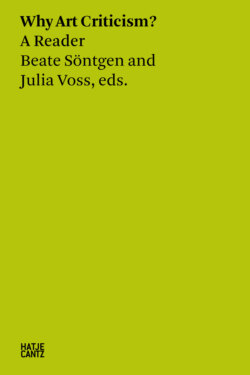Читать книгу Why Art Criticism? A Reader - Группа авторов - Страница 9
ОглавлениеPassion, Performance, and Soberness:
Denis Diderot
The Salons written by Denis Diderot (1713–84) are considered to be founding texts of modern art criticism. He wrote them on behalf of Friedrich Melchior Grimm for his publication Corréspondance littéraire, philosophique et critique, a handwritten magazine that was distributed to a select circle throughout Europe by diplomatic post in order to evade censorship. His writings were detailed commentaries on the Salons, the yearly exhibitions of the Académie Royale de Peinture et de Sculpture (Royal Academy of Painting and Sculpture) from 1665 onward, which were held in the Louvre’s Grande Galérie starting in 1699. Diderot’s art criticism represented only a small part of his work; he also wrote novels and stories, as well as dramatic theory and stage works. With Jean-Baptiste le Rond d’Alembert, he organized and authored the Encyclopédie. His conviction that empirical and rational observation should be accompanied by a sensual approach to the world that includes perception can be found in all of his writing, which distinguishes itself through its brilliantly rhetorical approach.
Between 1759 and 1781, Diderot wrote a total of nine articles under the title “Salons”; the densest are those from the seventeen-sixties. The fact that Diderot did not have the works in front of him while writing led to some imprecision. The form was not that of today’s art criticism, which is written for a large and anonymous newspaper audience. His readership was Europe’s political and intellectual elite, who were collectors as well, like Catherine II and Friedrich the Great. Diderot did not hesitate to recommend his most beloved artists to potential collectors.
Diderot himself was on a threshold. While coming from a culture of the emphatic contemplation of paintings, he was committed to the Enlightenment agenda of critical, distanced reflection. In his Salons, forms of passionate involvement with the subject are interwoven with cool observation, self-reflexively illuminating both the artists’ and his own practice. Diderot advocated for a kind of painting that would, like theater, portray everyday bourgeois life as an example, because the representation of what is familiar to the viewer touches them more profoundly and thus can better instruct them.
One of Diderot’s distinctive characteristics is the relationship of his writing style to the representations of the images he critiques. His writing adapts to what is being portrayed. His linguistic expressions evoke the themes, structures, and effects of the images in question, accentuating their particularities. The images thus become the expressive proof of Diderot’s theories of representation. It was in this way that Diderot’s impassioned descriptions of Jean-Baptiste Greuze brought out the emotionality of the viewer that he demanded, while showing how this was used for “moral education.” In the Salons on Chardin, however, a different, dispassionate speech oriented toward techniques of painting prevails, in which sociological aspects of art such as studio know-how and the conditions of production and exhibition become relevant. The focus here is on paint instead of subject matter, and new optical discoveries amalgamate with topoi from classical art literature, such as proximity to nature and vitality.
For Diderot, art criticism is not only the passionate and considered writing about an object. In his texts, which are arranged like theatrical scenes, the emotional entanglements in the image are presented just as convincingly as the reflexive refractions when passing judgment. Diderot articulates contradictions in imaginary dialogues, and in monologues he observes his own emotional reactions. The salons are a form of performative critique that shows itself and makes its methods transparent. To this effect, they conform to an ideal of self-reflexivity as a characteristic of modern culture, but without excluding sensual and even physical implementations of aesthetic experience and the writing on them.
There are three particular qualities in these texts that for me constitute an inspiring model for contemporary writing on art: First, the polyphony with which Diderot multiplies the perspectives on a particular work; second, his regard for the corporal in his reflection and writing; and third, his knowledge that the form of critique plays a role in the constitution of its object.
